Designs
Nuclear Fields has manufactured virtually every type of collimator, from unique research prototypes to standard production models. We were at the forefront in the development of Fanbeam, Conebeam and 511Kev collimators.
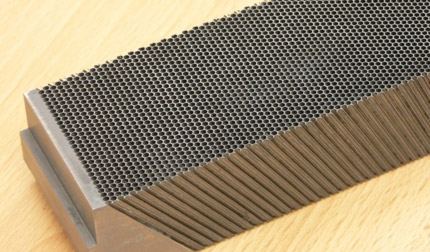
Fanbeam Collimator
Design Rules
There are some design rules that one should take into consideration. For Parallel hole collimators it is important to keep the septal penetration below 2%. Higher septal penetration will increase background noise, which can cause dramatic reduction in image resolution.
As for Fanbeam and Conebeam designs, the most important aspect is the accuracy of the focal point. Only with an accurate focal point you will be able to achieve the maximum gain in sensitivity without losing resolution. Note: foil constructed focusing collimators cannot be made accurately. Nuclear Fields Micro-cast collimators do pass through the geometric focal point or line within tolerances of only a few millimeters.
Five Basic Collimators
There are 5 basic collimator designs to channel photons of different energies, to magnify or minify images, and to select between imaging quality and imaging speed.
1. Parallel hole collimator
All holes are parallel to each other. Most common designs are Low Energy All-Purpose (LEAP), Low Energy High-Resolution (LEHR) and Medium- and High Energy Collimators.
LEAP collimators have holes with a large diameter. The sensitivity is relatively high as where the resolution is moderate (larger diameter holes allow more scattered photons). The average sensitivity of a LEAP is approx. 500,000 cpm for a 1-uCi source, and the resolution is 1.0cm at 10cm from the patent side of the collimator.
LEHR collimators have higher resolution images than the LEAP. They have more holes that are both smaller and deeper. The sensitivity is approx. 185,000 cpm for 1-uCi source, and the resolution is higher with 0.65cm at 10cm from the patient side of the collimator.
Medium Energy Collimators are used for medium energy photons of nuclides such as Krypton81, Gallium67, Indium111. High Energy Collimators are used for Iodine131 and F-18FDG. These collimators have thicker septa than LEAP and LEHR collimators (mainly used with Technetium 99m) in order to reduce septal penetration by the higher energy photons. |

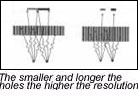
|
2. Slanthole collimators
A variation of the Parallel hole is the Slanthole collimator, which has all tunnels slanted at a specific angle. It generates an oblique view for better visualization of an organ, which view is (partly) blocked by other parts of the body. As an advantage, this collimator can be positioned close to the body for the maximum gain in resolution. |
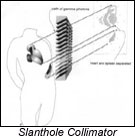 |
3. Converging and Diverging Collimators
In a Converging collimator the holes are not parallel but focused toward the organ. The focal point is normally located in the center of the field of view (FOV). Some Converging collimators have the focal point off-center near the edge of the FOV, (the so-called Half Converging). The organ appears larger at the face of the crystal with a Converging collimator. When the Converging collimator is flipped over you get a Diverging collimator, generally used to enlarge the FOV, for example used with portable cameras with a small crystal. |
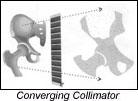 |
4. Fanbeam collimators
They are designed for a rectangular camera head to image smaller organs like the brain and heart. When viewed from one direction, the holes are parallel. When viewed from the other direction, the holes converge. This arrangement allows the data from the patient to use the maximum surface of the crystal. When the Fanbeam is flipped over it is called a Single Pass Diverging Collimator used for whole body sweeps. |
 |
5. Pinhole collimators
These cone-shaped collimators have a single hole with interchangeable inserts that come with a 3, 4 or 6 mm aperture. A pinhole generates magnified images of a small organ like the thyroid or a joint. Most Pinhole collimators are designed for low energy isotopes. |
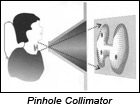 |
All above collimators can be tuned for any type of isotope. Next to the standard collimator of your gamma camera, Nuclear Fields can tailor make and optimize it for any specific application. Please contact us to discuss your collimator needs.













